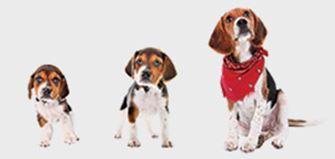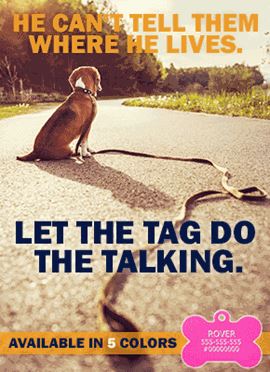
Do Dogs Recognize Our Faces?
Your dog rushes to greet you at the door when you come home, seeks you out at the dog park, and is always ready to comfort with a lick or a paw.
You and your canine may share a truly special bond, but does your dog recognize your face? Could he pick you out of a crowd?
Scientists originally speculated that only humans and other primates had the ability to recognize faces, but new research into the canine brain has turned that theory on its head.
BRAIN MATTER
Researchers at Emory University in Atlanta discovered that dogs have a specialized region in their brains for processing faces. The study was undertaken as part of the Dog Project, which was established in Emory's Department of Psychology to better understand the canine mind. “Dogs are obviously highly social animals, so it makes sense that they would respond to faces. We wanted to know whether that response is learned or innate,” says Dr. Gregory Berns, a neuroscientist at Emory and the senior author of the study, in a university release.
Using functional magnetic resonance imaging (fMRI), a technique that detects increased blood flow to stimulated areas of the brain, the scientists compared how a dog’s brain reacted to faces versus ordinary objects. They found that a specific area of the canine brain responded much more to videos featuring human faces than movies of everyday items. This region of the brain, dubbed the DFA or “dog face area,” showed a similar reaction to photographs, with a stronger response toward faces (both human and canine) than pictures of objects.
Dr. Berns explains that if the behavior was learned, such as associating a human’s face with receiving food, then the facial images would activate the brain’s reward center. “Our findings show that dogs have an innate way to process faces in their brains, a quality that has previously only been well-documented in humans and other primates,” he reports in a university release. While only six dogs participated in the study (recruiting subjects is difficult since the dogs need to be trained to remain motionless during the MRI scan and also to work with 2D images), the results were consistent.
The DFA was detected in the right hemisphere of the brain in all six dogs. This special feature could explain why dogs and humans have shared such a strong relationship through history. If dogs are hardwired to process human faces, then it’s likely one of the main reasons they became man’s best friend.
FACE FACTS
Facial recognition is an important skill for social animals, and studies now show that it’s one of the ways dogs identify their owners. A 2010 study at the University of Padua in Italy reported that dogs know the faces of their humans and can distinguish their owners from other people by their facial characteristics. In the first part of the study, a dog watched its owner and a random stranger walk in opposite directions several times before they exited through separate doors. The research team measured the amount of time each dog spent watching both people and noted which door the dog focused on after they left. Not surprisingly, most pooches spent the majority of their time observing their owners. They then chose to wait by the door where the owner had exited.
The scientists then repeated the experiment, except this time both of the humans had their heads covered with cloth sacks. Without being able to see their faces, the dogs had more difficulty telling the two masked individuals apart. They paid significantly less attention to the owner during this phase of the study, which means that dogs do rely on facial features to recognize their owners.
Research conducted in 2013 at the University of Helsinki in Finland also supports the idea that dogs identify and remember familiar faces. Technicians showed 31 dogs a series of pictures on a monitor and gauged their interest by tracking eye movements. The photos included both familiar and unfamiliar human faces, as well as the faces of other dogs (some familiar and some unknown). The images alternated between being upright and upside-down.
The findings revealed that the dogs spent more time viewing facial images of people they know than pictures of strangers. The canines viewed the upright images for the same amount of time as inverted photos, but they focused their attention on the eyes of the upturned faces (as humans do). While the dogs repeatedly gazed at familiar humans, they actually spent the most time looking at other dogs.
EXPRESS DELIVERY
Dogs may recognize our faces, but what about our expressions? New research from the University of Veterinary Medicine, Vienna, strongly supports the idea that dogs can identify and differentiate the facial expressions of humans. By showing dogs a pair of pictures featuring the same person expressing a different emotion on each, the researchers watched canines distinguish between happy and angry expressions on faces they knew and faces they had never seen before.
“[As dogs] spend a lot of time with human beings, reading their faces becomes a very evolutionary valuable skill for them to have,” says Philip Tedeschi, the executive director of the Institute for Human-Animal Connection at the University of Denver’s Graduate School of Social Work, “and so they have become better and better at it.” Professor Tedeschi says that as humans grow more dependent on communicating electronically, they lose some of their ability to interpret emotional cues. Since dogs tend to rely on behavioral signals for information, they have become skilled at communicating with people by reading facial expressions and other mannerisms.
In fact, Tedeschi says that our dogs sometimes know us better than the people closest to us. With a healthy dose of socialization, dogs can hone in on an individual’s expression and see things others likely can’t or won’t. “Dogs that are socialized . . . they’ve become really good at reading facial expressions and probably notice details that most of us as humans now largely ignore in one another, including people very close to us,” he says. “So we can live with somebody and ignore the effect of slight facial expressions . . . but dogs actually use that information in a functional way to determine what’s happening around them.”
This is one reason why dogs make such wonderful companions. By simply reading our faces, they know when we need comfort or even just someone to sit next to. “They’re scanning your face constantly,” Tedeschi says. “They’re watching you a lot.”
HI, TECH
So does this mean you should start Skyping with your dog while you’re at work? Probably not. Since technology like Skype and FaceTime can present a skewed image of your face, your dog might stare at the screen feeling more confused than comforted. Professor Tedeschi says that while sound quality is often very good, the clarity of computer and device screens can vary, so it’s hard to accurately judge whether dogs understand what they are seeing. “We don’t really know for certain, but if the animal thinks that person is around in the house, [and] they hear their voice but can’t find them, that could create anxiety and distress,” he says.
But, as technology continues to improve, there is certainly hope for the future. Tedeschi notes that recent advances in pixel quality (such as images on a high-definition television) are making screens more realistic, and the higher refresh rates of newer TVs allow dogs to view moving images much like we do, so pets should be able to see our faces clearly on-screen someday soon. Also, with new developments in the field of home hologram tech, you will be able to speak to your dog remotely through a 3D-projected image in the not-so-distant future.
Most of us can’t help wanting to check in on our pets during the day, if only to make sure they’re alright. Luckily, technology is turning our desire for more face-to-face time with our pets into reality. Even when we’re far away from home, soon smart devices will let us bring our beloved canine buddies wherever we go. And when our dogs see our smiling faces, they won’t have to feel lonely anymore. Now that’s hi, tech.












